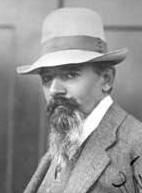Presents
Paul Juon
 |
String Quartet No.1 in D Major, Op.5
The British critic Edwin Evans, writing in The Cyclopedic Survey of Chamber Music called Paul Juon's String Quartet No.1 "An attractive work, showing a mature conception of the quartet style combined with originality of outlook."
Paul Juon (1872-1940) is widely regarded as the link between Tchaikovsky and Stravinsky. In his early music, one can hear the influence of his Russian homeland and schooling. Of course, Juon recognized that though he had been born in Russia and schooled there, he was a still foreigner living among Russians. His second period is more cosmopolitan and is in tune with the contemporary Central European trends of the early 20th century. Ultimately, it is hard to characterize his music as Russian or German, Romantic, Modern or Folkloric, because one can find all of these elements in his music.
Paul Juon was the son of Swiss parents who emigrated to Moscow where he was born. Educated at the Moscow German High School, he entered the Moscow Conservatory where he studied violin with Jan Hrimaly and composition with Anton Arensky and Sergei Taneyev. After graduating, he went to Berlin for further composition instruction from Woldemar Bargiel (we have published Bargiel's Piano Trio No.1). In 1906, after holding various posts in Russia, Juon was invited by Joseph Joachim head, of the prestigious Berlin Hochschule für Musik, to be a Professor of Composition. It was a post he held until 1934 at which time he moved to Switzerland, where lived for the rest of his life.
During his lifetime, Juon was widely regarded as an important composer and his works were given frequent performance throughout Europe. Chamber music plays a large part of his total output which numbers more than 100 works.
Juon's First Quartet dates from 1898. It is a huge work--tonally at times approaching the orchestral and in length approaching the symphonic. The opening Allegro moderato has powerful Russian-sounding theme for its first subject. The beautiful and lyrical second theme also is of Russian origin. The broad Adagio sostenuto which follows takes its time, like a slowly flower unfolding in the sun, to reveal the fullness of its extended melody. A happy, energetic Scherzo, molto presto, in the tradition of Taneyev, serves as the middle movement. A gorgeous and highly romantic trio section brings contrast. A brief Intermezzo, in the form of a contrapuntal baroque minuet, is used a "palette cleanser", the theme is Russian. The finale, Vivacissimo, is a rondo, which brings back the main theme of the opening movement only to give it an completely different treatment. A pounding Russian rhythm takes the music in an entirely different and exciting direction.
Here is a long unavailable but first rate work from start to finished. We are pleased to reintroduce it and hope that professionals and amateurs alike will give it a chance on their music stands.
Parts: $29.95